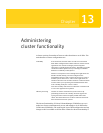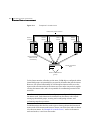
Chapter
13
Administering
cluster functionality
A cluster consists of a number of hosts or nodes that share a set of disks. The
main benefits of cluster configurations are:
The cluster functionality of Veritas Volume Manager (CVM) allows up to 16
nodes in a cluster to simultaneously access and manage a set of disks under
VxVM control (VM disks). The same logical view of disk configuration and any
changes to this is available on all the nodes. When the cluster functionality is
Availability If one node fails, the other nodes can still access the shared
disks. When configured with suitable software, mission-critical
applications can continue running by transferring their
execution to a standby node in the cluster. This ability to provide
continuous uninterrupted service by switching to redundant
hardware is commonly termed failover.
Failover is transparent to users and high-level applications for
database and file-sharing. You must configure cluster
management software, such as Veritas Cluster Server (VCS), to
monitor systems and services, and to restart applications on
another node in the event of either hardware or software failure.
VCS also allows you to perform general administration tasks
such as making nodes join or leave a cluster.
Note that a standby node need not remain idle. It could be used
to serve other applications in parallel.
Off-host processing Clusters can reduce contention for system resources by
performing activities such as backup, decision support and
report generation on the more lightly loaded nodes of the
cluster. This allows businesses to derive enhanced value from
their investment in cluster systems.


















